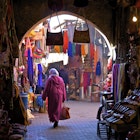
Four ways to explore Chefchaouen, Morocco's blue city
Feb 28, 2014 вҖў 4 min read

Wander through Chefchaouen's famous blue streets. Christine Wehrmeier / Getty Images
Chefchaouen is an otherworldly escape nestled in MoroccoвҖҷs Rif Mountains. As well as its distinctive palette of blue and white buildings, a striking contrast with the arid setting, this popular town has plenty to offer. Embark on strenuous hillside hikes or idle strolls, bathe in mountain streams, or embrace the culinary scene and excellent shopping. Here's how to tailor a trip to Chefchaouen to four different travel styles.
Chefchaouen for history buffs
Founded in 1471 by Moulay Ali Ben Moussa Ben Rached El Alami, Chefchaouen served as a Moorish fortress for exiles from Spain. Over the centuries, the city grew and welcomed Jews and Christian converts alike. Chefchaouen's powder-blue buildings mirror the cloudless Moroccan sky, but religious rather than stylistic reasons are behind the design choice. Jewish teachings suggest that by dyeing thread with tekhelel (an ancient natural dye) and weaving it into prayer shawls, people would be reminded of GodвҖҷs power. The memory of this tradition lives on in the regularly repainted blue buildings.
Nowadays Chefchaouen is a rich cultural tapestry of Berber tribespeople, Muslims and Jews, along with descendants of the Moorish exiles from Spain who lived there in the 1400s. Berber tribespeople can be seen wearing distinctive cotton clothing paired with woven hats, which are decorated with brightly coloured threads.

Chefchaouen for explorers
Tucked away in AfricaвҖҷs northernmost mountain range, the Rif Mountains, Chefchaouen has plenty to offer fitness fanatics and those looking for adventure. Valleys, gorges and picturesque peaks are in abundance where arid landscapes meet trickling mountain streams. Both multi-day treks and day trips are available, all of which start in Chefchaouen. Some routes pass the nearby village of Jevel El Kelaa, a little north of the city, through Afeska, passing through lush green forests and offering with views of the Mediterranean Sea.

Nights are spent under cloudless skies speckled with constellations unobstructed by light pollution. Alternatively, accommodations are available in some villages, ranging from budget backpacker hostels to luxury hotels. A two-day trek with starts in Chefchaouen, passing a natural spring on the way to a small village in the Talasemtane National Park. A night spent in a small mountain lodge is followed by a visit to the Farda River and GodвҖҷs Bridge before a picnic lunch, a stop off at Akchour and a transfer back to the blue city. With , visitors can explore on mule-back.
Whatever the season, visitors are guaranteed incredible views. April to June is a popular time of year for trekkers. Chefchaouen is prone to dustings of snow in winter and may be more challenging for hikers (experience recommended).

Chefchaouen for foodies
Your taste buds won't know whatвҖҷs hit them after a few days in the city, with the hundreds of spices, aromatic herbs, variety of textures and tantalising smells. Kick off your day with a bakery trip: bread is baked in a traditional wood-fired oven, giving it a distinctive taste and crunchy outer layer.
For lunch, try the townвҖҷs signature tagine: a typical Moroccan-style dish made with fish, vegetables, spices and oil served on a bed of fluffy couscous. The dish, which is also served up at dinner, often includes ras el hanout, a tangy blend of around 30 spices including turmeric, paprika, cardamom, chilli, cumin, cinnamon and more. Try one of these tagines, grilled meats or succulent fish dishes at Casa HassanвҖҷs . A guesthouse-cum-restaurant, the eatery is popular with both locals and tourists, and many return again and again. Its open-plan kitchen allows a sneak peek into the preparation of the many dishes on offer.
Polish off each meal with a refreshing mint tea, made by boiling green tea leaves and adding fresh mint and a generous helping of sugar. The tea is reputedly great for your health and is an important part of Moroccan life, as many locals meet for daily discussions over a steaming pot in one of the many cafes that line the higgledy-piggledy alleyways.
Chefchaouen for shopaholics
Quaint and colourful, ChefchaouenвҖҷs medina is like stepping into another world. Nestled in the crooked hillside streets, the medina is an addictive emporium for those looking to burn a hole in their pocket. Brass teapots and plates glint from the shadows. Handwoven blankets and shawls conceal walls and tables. Tortoises scramble for lettuce leaves in blue plastic baskets. Aztec-patterned bags and Moroccan slippers lie in haphazard piles, spilling from sacks into the streets.
For silver plates and jewellery, stop at the sheltered trove along Hassan 1, where trinkets balance in precarious stacks and line the walls. A little further along the cobbled path you'll find cardigans, shawls and blankets made from sheepвҖҷs wool or camel hair are draped from rafters. Follow the hillside down to the Kasbah to an organised scattering of handmade tagine clay pots, decorated with delicate artistry and piled high for the taking.

Before you get too carried away filing your bags with gems and jewels, carpets and spices, itвҖҷs best to learn the art of haggling. In Morocco, youвҖҷll be expected to barter for your wares, battling for the best price possible. Ask the vendor his price before making your offer, then swiftly halve his request. Gently edge higher until you meet a compromise, and always end with a smile and a shukran to thank them.
Explore related stories




 HikingThe 5 best treks in Morocco for wildlife, Roman ruins and mountain summits
HikingThe 5 best treks in Morocco for wildlife, Roman ruins and mountain summitsFeb 8, 2023 вҖў 5 min read




